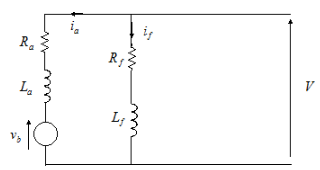Shunt Motor
Shunt motor with electrical and torque characteristics
Libraries:
Simscape /
Electrical /
Electromechanical /
Brushed Motors
Description
The Shunt Motor block represents the electrical and torque characteristics of a shunt motor using the following equivalent circuit model.

When you set the Model parameterization parameter
to By equivalent circuit parameters, you specify the
equivalent circuit parameters for this model:
Ra — Armature resistance
La — Armature inductance
Rf — Field winding resistance
Lf — Field winding inductance
The Shunt Motor block computes the motor torque as follows:
The magnetic field in the motor induces the following back emf vb in the armature:
where Laf is a constant of proportionality and ω is the angular velocity.
The mechanical power is equal to the power reacted by the back emf:
The motor torque is:
The torque-speed characteristic for the Shunt Motor
block model is related to the parameters in the preceding figure. When you set the
Model parameterization parameter to By rated
power, rated speed & no-load speed, the block solves for the
equivalent circuit parameters as follows:
For the steady-state torque-speed relationship, L has no effect.
Sum the voltages around the loop:
Solve the preceding equations for ia and if:
Substitute these values of ia and if into the equation for torque:
The block uses the rated speed and power to calculate the rated torque. The block uses the rated torque and no-load speed values to get one equation that relates Ra and Laf/Rf. It uses the no-load speed at zero torque to get a second equation that relates these two quantities. Then, it solves for Ra and Laf/Rf.
The block models motor inertia J and damping B for all values of the Model parameterization parameter. The output torque is:
The block produces a positive torque acting from the mechanical C to R ports.
Model Thermal Effects
You can expose thermal ports to model the effects of losses that convert power to heat. To expose the thermal ports, set the Modeling option parameter to either:
No thermal port— The block does not contain thermal ports.Show thermal port— The block contains multiple thermal conserving ports.
For more information about using thermal ports in actuator blocks, see Simulating Thermal Effects in Rotational and Translational Actuators.
Examples
Ports
Conserving
Parameters
References
[1] Bolton, W. Mechatronics: Electronic Control Systems in Mechanical and Electrical Engineering, 3rd edition Pearson Education, 2004..
Extended Capabilities
Version History
Introduced in R2008a

